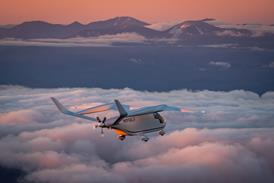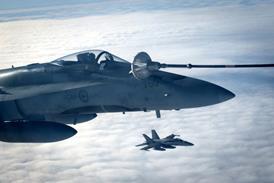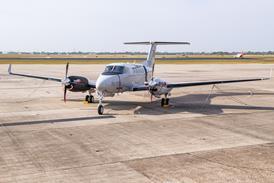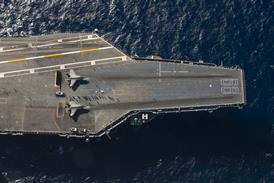It has been 60 years since German rocket scientist Werner Von Braun relocated to a small North Alabama community named Huntsville to continue his pioneering research. Anchored by Von Braun's legacy with NASA rockets and army missiles, the city has grown into one of the largest aerospace hubs in the south. In the mid-1990s, the army also shifted its helicopter acquisition headquarters to Huntsville from St Louis.
More recently, the latest round of base realignments mean that the Missile Defense Agency is transferring thousands of jobs to Huntsville as well. Now the community is waiting to learn how it may prosper from the fate of several programmes, includes NASA's Ares rocket programme and shifts in the MDA budget.
Stephen Trimble interviewed John Southerland and Mike Ward, communications direc tor and vice-president of economic development, respectively, for the local chamber of commerce.
  |
|---|
John Sutherland (left) and Mike Ward (right) |
What does Huntsville's delegation to the Paris air show hope to achieve?
SOUTHERLAND: For us it's an opportunity to talk to some of those international companies, in some instances to introduce ourselves to the companies that have purchased other local companies.
So you've got Cobham and Qinetiq and BAE Systems and others that have established a presence. In some instances it's getting to know the leadership of those companies.
In some instances you're talking to domestic companies that already have a presence in the community. But the leadership of those companies are sometimes difficult to be with, and [in Paris] you're in this target-rich environment with chief executives and chairmen of the board.
For us it's a good opportunity not just to tick off some new boxes, but maintain relationships with others.
A lot of traditional aerospace clusters in the US have been bypassed more and more especially by the foreign companies. Is Huntsville concerned about the competition.?
WARD: We're not doing a lot of the manufacturing. We're doing all the research and development. So that's our target area when you're talking about what Huntsville does, with Redstone Arsenal, with NASA, with the army it's primarily all research and development work.
We've got 33,000 jobs opening up in our community in the next four or five years. There's a high level of those that require advanced engineering skills.
SOUTHERLAND: And we've seen a pretty good uptick in that with FMS - foreign military sales. The Iraqi military asked the US military to provide some [helicopter] trainers. AMCOM procured some Bell helicopters and then retrofitted them to be trainers. The Iraqis said they liked them a lot and they asked them further if they could be modified into armed reconnaissance helicopters. So we've got a local company - SES - they had been doing modification work on Chinooks. In addition to that, they are taking Bell helicopters and turning them into armed reconnaissance helicopters.
So from a community standpoint that's a toe-hold into the manufacturing sector?
SOUTHERLAND: That wasn't the first. But that's the biggest one.
The Missile Defense Agency (MDA) is getting hit pretty hard in the budget, and that's a big part of the BRAC amount. Has that changed your analysis yet?
SOUTHERLAND: I think those are just preliminary estimates. Until you see the real budget it's hard to say with certainty. But, from MDA, what got cut? Airborne Laser got whacked. We don't do any ABL work in our part of the world. KEI [Kinetic Energy Interceptor] - it looks like it's going to do all right. The MKV - multiple kill vehicle - it looks like it's going to get whacked but that was a development programme. It probably only had 150 people in Huntsville anyway.
The bottom line for me though - while I'm sure it will have an impact on the agency - it's probably not going to have a negative impact on the community. MDA is moving more work into the community.
So that's going to offset those job losses.
WARD: There was also an increase for the [terminal high altitude air defence] THAAD programme and some other missile defence programmes that we also do.
So the missile defense picture wasn't just cuts. There were some programs that were actually picking up - I think $500 million for THAAD.
When most people think of Huntsville even internationally my guess is they think of NASA. Do you agree?
SOUTHERLAND: Yes, NASA is about 7,500 employees and contractors on post. And there are 32,000 people that work at the arsenal. So that gives you some sense of the mix. But NASA is what we're best known for, yes.
WARD: That is our heritage and people see us as a rocket town. You're talking about the same kind of jobs there. Every engineering discipline you can imagine works on the army side out there. There's only 1,200 troops at Redstone. Everybody else is a civilian.
For NASA this is a period of major transition to say the least with the new programmes, and where the Space Shuttle is going to be headed, and how that it is going to be managed, how do you think Huntsville comes out of that down the road?
WARD: He was very direct about saying these guys there is absolutely nothing out there is anything that is going to happen to change our approach to Ares. He said, I assure you this is not so unusual at NASA to go some period of time without an administrator. The goals are there. The objectives are there. Keep your nose down and focus on it. It was very interesting.
SOUTHERLAND: The way it affects us is, we've got the Marshall Spaceflight Center, which manages all of the propulsion elements on the Shuttle and the external tank.
It works pretty well as far as Marshall is concerned as work on shuttle is scaling down, work on Ares is scaling up. So it's a very steady state. There's practically no change in the levels of employment at Marshall. The shuttle is still considered a development programme. I don't think any spacecraft achieves full operability.
WARD: They're doing some tests for Ares out there now.
What have you got planned for Paris?
SOUTHERLAND: Our community has participated in the Paris air show since the mid-1980s. And that presence has grown. Senator Richard Shelby [of Alabama] is honoured at a reception, and has been for the last several shows. And it's become a very well attended event. That includes the presidents and chairmen of the some of the world's largest aerospace companies. Ron Sugar has come on a couple of occasions. Other very senior people with Boeing and the other aerospace companies are there.
So for us it's an opportunity to create top of mind awareness as companies in the aerospace business are expanding their operations. We hope to be one that's on the top of their mind as they consider different sites for activities. Where people do work on some of these programmes has yet to be determined. This is our opportunity to in itself to capitalize on those opportunities.
So you see Paris as almost an opportunity to reach out to the US companies that aren't so much inaccessible here, but are in accessible there?
SOUTHERLAND: Frankly you can meet with a lot more of them in a relatively short period of time. All of the decision makers are here at the Le Bourget show.
There's no other place that you could do anything like this.
- All the latest news, images and video from the Paris Air Show
Source: Flight Daily News























